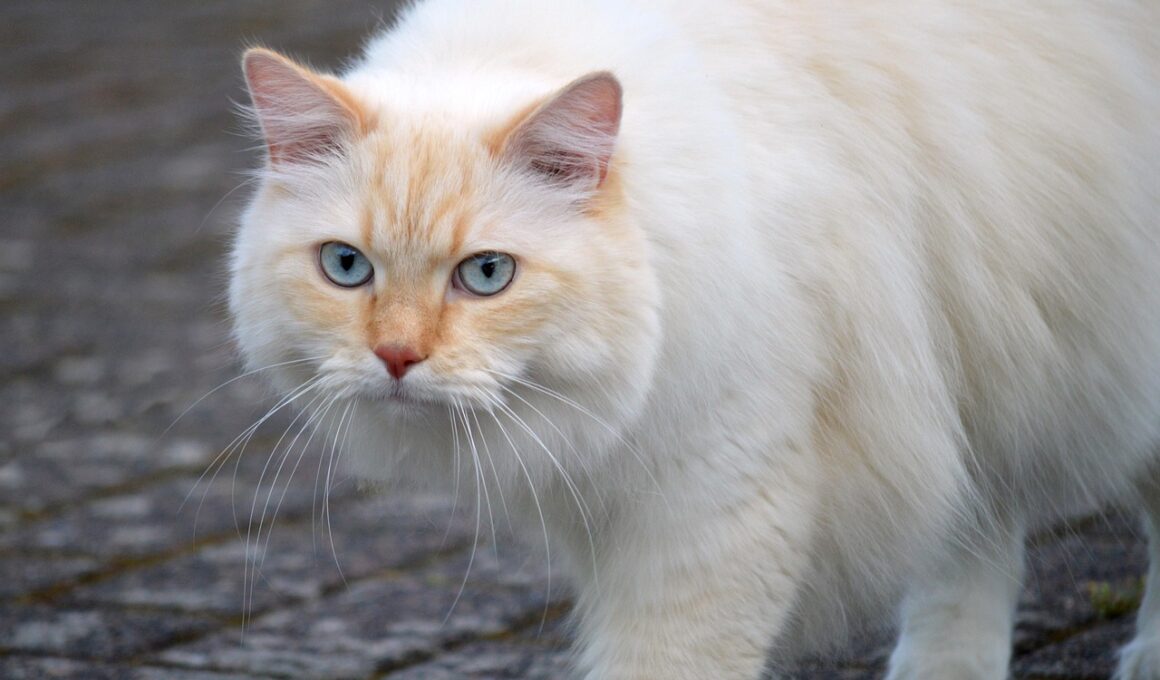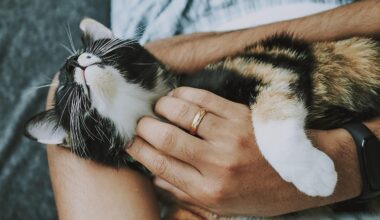Understanding the Body Language of Cats: A Comprehensive Guide
Cats communicate a variety of messages through their body language. Understanding these signals is key to creating a harmonious relationship with your feline friend. For instance, consider tail movements: a cat with a straight-up tail is typically happy and confident. On the other hand, if a cat’s tail is puffed up, it signifies fear or aggression. Another important aspect involves ears; forward-facing ears indicate curiosity or excitement, while ears that are flattened against the head express discomfort or aggression. Watching their posture is also essential; relaxed cats often lie down with their bodies stretched out, signifying trust. Conversely, a cat carrying its body low to the ground may be feeling threatened. This communication can be subtle, so it’s after observation and responsiveness that you’ll truly understand them. Moreover, vocalizations such as meows and purrs can accompany or enhance these body signals. Since cats are masters of non-verbal communication, closely observing their movements can greatly improve your interactions and bond with them over time. Being aware of these signs fosters a healthier environment for both you and your beloved pet.
The Significance of Tail Movements
The tail is an essential tool for feline communication that reflects complex emotions. A cat’s tail can convey multiple feelings, such as happiness and anger. When a cat’s tail is held high, it often indicates confidence and a friendly demeanor. In contrast, if their tail is tucked between the legs, this implies fear or submission. An agitated cat may swish its tail or hold it horizontally, signaling irritation or hostility towards another animal or human. Observing the nuances of tail movements is crucial; sometimes, certain variations are subtle but revealing. For instance, the tail may quiver or vibrate, typically seen in situations where a cat expresses enthusiasm or readiness to pounce. Additionally, a side-to-side motion can be associated with annoyance, indicating that the cat is displeased. It is crucial to take note of these signals and react accordingly to maintain a positive interaction. Recognizing these tail signals can help nurture a more profound understanding of your cat’s mood and needs. This understanding ultimately strengthens the bond you share with your beloved pet.
Understanding Ears and Eyes
Cats’ ears and eyes play significant roles in their body language, often expressing emotions and intentions. A cat’s ears provide insight into its mood; for example, upright and forward-facing ears signal interest or curiosity, while ears pointing back can indicate agitation or irritation. Pay attention to the degree of ear positioning, as slightly tilted ears might reflect curiosity but with caution. Eye behavior is also critical; wide-open eyes suggest a relaxed state, while slow blinking can signal affection or trust. Conversely, if a cat’s pupils are dilated, this could indicate fear, excitement, or aggression, depending on the context. Eye contact duration also matters; prolonged staring can be perceived as a threat, while averting their gaze suggests submission or comfort. Some cat owners find that mirroring this slow blink can enhance their relationship with their pets. Furthermore, the movements of their whiskers, which also serve as sensory tools, can provide additional cues about their state of mind. Not only do these elements define closeness and comfort with their owners, but they also offer insight into interactions with other pets.
Posture and Movement
The posture of a cat—how they position their body—offers deep insight into their feelings. For example, a cat lying on its side with its belly exposed typically conveys trust, indicating that it feels safe in its environment. Conversely, if a cat hunches down and appears poised to spring, it may indicate fear, anxiety, or a readiness to play or fight. Observing a cat’s movements, such as prowling or pouncing, also conveys their intentions. A cat that approaches you with a fluid gait, swaying hips, might express friendliness and comfort. On the other hand, a cat that approaches cautiously, with a low body posture, shows signs of wariness or submission. When engaging with other cats or pets, you may notice a playful bow; this indicates an invitation to play, showcasing both joy and excitement. Consequently, being attuned to these postures promotes understanding and fosters a positive atmosphere for your cat’s emotions. This awareness allows pet owners to respond appropriately and create a more harmonious living environment for the entire household.
Vocal Communication
While body language is critical in feline communication, vocalizations add another layer of interaction. Cats make various sounds, including meows, purrs, growls, and hisses, each carrying different meanings. For instance, a repetitive meow may indicate a request for attention or food, while softer, longer meows can express contentment. Purring is often associated with happiness but can also occur during stressful moments, serving as a self-soothing mechanism. Understanding the context in which these noises occur is vital for interpreting their meanings accurately. Cats also use growls and hisses to warn of impending aggression or to assert dominance during a threat. Similarly, you may observe how vocalizations can change when interacting with different people or other animals; they might adopt a more urgent tone when they feel challenged or threatened. Additionally, interestingly, cats rarely meow at one another but reserve this behavior primarily for humans. Being aware of these vocal cues can enhance your connection with your furry friend, making it easier to meet their needs and desires more effectively.
Facial Expressions
Facial expressions in cats offer precious clues about their emotions. Understanding your cat’s face can deepen the bond shared between you and your pet. Cats utilize their eyes, mouth, and even whiskers to express feelings. A relaxed cat often has half-closed eyes, signaling comfort, while wide-open eyes can indicate fear or aggression. Observe the mouth; a cat that shows its teeth might be ready to fight, while a relaxed mouth conveys calmness. Additionally, observing whiskers can identify a cat’s state of mind; forward whiskers signal curiosity and interest, while whiskers pulled back indicate caution or annoyance. Ear positions, as discussed earlier, augment the facial cues, enriching the overall emotional landscape of the cat’s communication. When cats squint their eyes or slowly blink at you, it may suggest trust and affection, essentially saying they feel safe. Recognizing these facial signals aids in enhancing communication between you and your cat, leading to fewer misunderstandings and a more fulfilling companionship. A keen eye for these details allows for enhanced interactions, ensuring a healthier, more connected relationship over time.
Understanding Triggers and Environment
Environmental factors and specific triggers can influence a cat’s body language significantly. Various elements, such as strangers, noises, or smells, may prompt distinct behavioral responses in cats. For instance, a usually calm cat might exhibit stressful signals, such as hiding or aggressive posturing, when faced with unfamiliar visitors or situations. It’s essential to maintain a safe and predictable environment, as sudden changes in routine can unsettle a cat, leading to anxiety-driven behaviors. Identify your cat’s stress triggers and help them gradually acclimate to new experiences. If you notice your cat displaying defensive behaviors, such as hissing or scratching, reassess their environment. Additionally, socialization with other animals helps them develop positive behaviors over time, promoting peaceful interactions. Providing interactive playtime and mental stimulation aids in reducing stress-related expressions in your cat. By understanding these elements, you can create a more nurturing space that caters to their needs and supports emotional well-being. Ultimately, recognizing how the environment influences your cat’s behavior furthers your connection and enhances your ability to respond appropriately.
Conclusion: Enhancing Human-Feline Relationships
In conclusion, understanding cat body language is vital for enhancing the bond between humans and felines. By paying close attention to their signals, you become more attuned to their needs, emotions, and underlying states of mind. Recognizing tail positions, ear movements, vocalizations, and facial cues allows for better interactions. Additionally, being aware of environmental triggers enables proactive management of your cat’s behavior. Positive reinforcement and socialization help encourage healthy communication patterns. The relationship you build with your cat will flourish as you learn to navigate their complex language of body signals. This connection fosters empathy and companionship, leading to a happier, more enriched life for both you and your pet. With time and observation, you can unlock the mystery of your cat’s emotions, ensuring you provide the love and care they require. As you become more knowledgeable, you can advocate for your cat’s needs, suggesting a deeper emotional understanding. Understanding a cat’s unique body language allows you to be a more compassionate and responsive pet owner, ultimately leading to a lifelong bond filled with love and trust. Invest in learning your cat’s language; the rewards are immeasurable.


